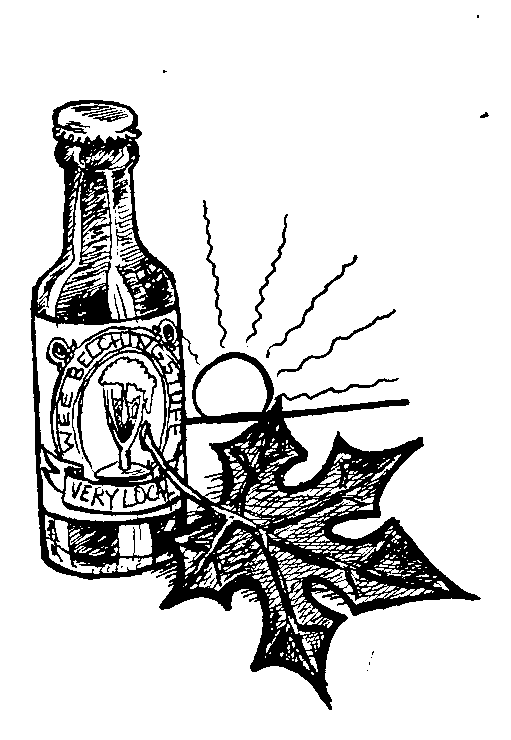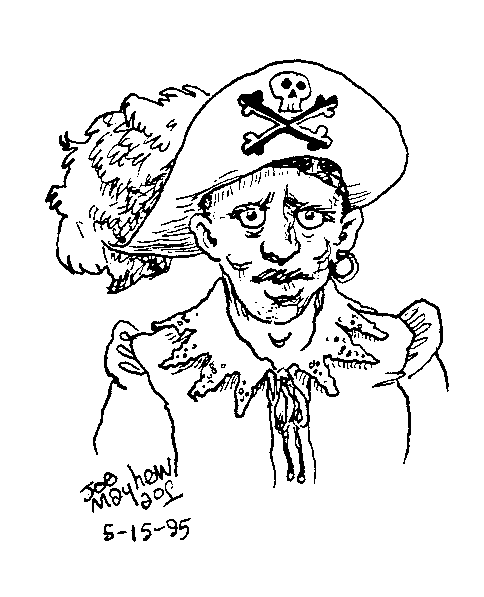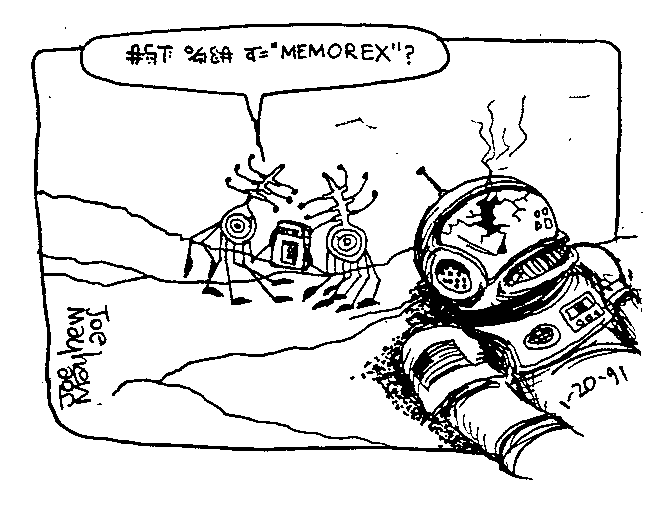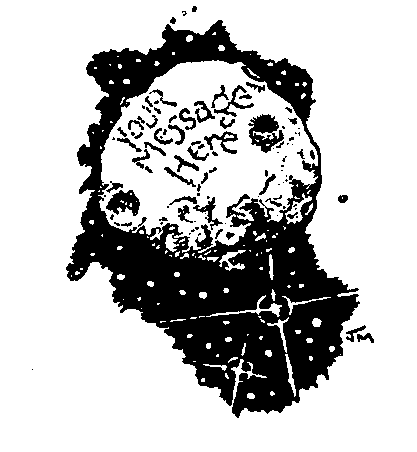

The Official Newsletter of the Washington Science Fiction
Association -- ISSN 0894-5411
Edited by Joe Mayhew
Chuck Divine's End of Summer Party
WSFA Minutes September 1, 1995 at Gilliland's
No Spaceship, Will Travel
Science Fiction: Loving the Alien
Bucconeer Victory Celebration
WSFA 5th Friday at the Bungalow
More Reviews
Space Tom

WHILE CHUCK IS PROVIDING THE STUFF, FEEL FREE TO BRING ANYTHING EXCEPT BEER. CHUCK IS GOING TO HAVE A LOT OF LOCAL MICRO BREWERY STUFF.
[ Directions censored ]
[ Map censored ]
[ misprinted as "1955" in the original ]
Attending: Pres. Covert Beach, Sec. Joe Mayhew, Treas. & 96 Chair Bob MacIntosh, Trust. David Grimm, Trust. John Pomeranz, 97 Chair Mike Nelson, Dan Burgess, Elspeth Burgess, Steven desJardins, Jill & Donalds Eastlake III, IV, Alexis Gilliland, Lee Gilliland, Michael Harrington, Chris Holte, Eric Jablow, Kitty Jensen, Quin Jones, Brian C. Lewis, Samuel Lubell, Dick Lynch, Nicki Lynch, Keith Marshall, Winton Matthews, Walter Miles, Barry Newton, Judy Newton, Peggy Rae Pavlat, Rebecca Prather, Dick Roepke, John Sapienza, Tom Schaad, George R. Shaner, Debbie Smith, Steven Smith, William Squire, Rich Stoddard, Michael J. Taylor, Ronald C. Taylor, James Uba, Michael J. Walsh, Michael Watkins, Ted White, Madeline Yeh.
Covert called the meeting to order at 9:18, there was no outstanding agenda.
Bob MacIntosh said we had $7,822.11
DISCLAVE 1997
Mike Nelson announced that Peggy Rae Pavlat would be Fan GOH. Others still to be announced. Members are needed for the 1997 Disclave Committee. All positions are still open. Please contact him for more information at: Michael Nelson [ street address censored ] Phones: (703) 385-3736 (H, 5 pm to 10 pm) (202) 874-3093 (W, 7:30 am to 3:30 pm) [ email address censored ].
TRUSTEES:
The Trustees will announce constitutionally required nomination(s) for Chair of Disclave 1998 at the September 15th WSFA meeting. The election will take place at Gilliland's after the 6th of October First Friday meeting. Members may nominate others from the floor at that time. Persons nominated from the floor will require a second and must actually consent to the nomination (presumpton is not sufficient).
5th FRIDAY IN SEPTEMBER PARTY
John Pomeranz has graciously offered his place for the September 29th party. Directions are published in the Sept 15th WSFA JOURNAL.
NO BUSINESS WAS CONDUCTED
The meeting was adjourned at 9:42
 S
S
You've all heard the expression, "I'll take Manhattan." Well in John Stith's MANHATTAN TRANSFER, aliens do just that--steal Manhattan off the face of the Earth and install it in their collection of domed cities. Why, and what they have planned for the humans they've captured is part of the fun of this action-adventure.
The first third of the book is devoted to the humans coping, rather resourcefully with the disaster. The hero, a military colonel in the city to visit a friend who just happens to work for the mayor (a black woman--take that Rudy!) talks his way into building a team to translate the mysterious message the aliens have written on the top of the dome. In the middle third, the colonel, a translator, a computer/video expert, and the colonel's friend take an underground boring machine to visit some of the other alien cities that have been captured in the same way as Manhattan. What they learn tells them that more is at stake than just Manhattan and forces them to confront the alien city-snatchers once and for all.
There are some light moments in the book, such as a fight between the hero and some looters in low gravity; the comparisons of the do(o)med city to bird feeders, hamsters, and ant farms; and the character of Bobby-Joe, sort of the ultimate techno-nerd. These humorous touches aside, the bulk of the book concentrates on straightforward exploration of the other cities around them and the giant alien ship that holds them captive. Politics is not really present; there is a small subplot of a preacher who opposes the mayor's attempts to communicate with the aliens, but this is the weakest part of the book.
What holds the reader's interest is the inventiveness of the situation, the aliens they contact, and the author's slow revealing of information that radically changes the entire picture of what is happening. Although characterization is not emphasized, there is enough for the characters to be distinguishable and to have real motivation for their actions.
Two small quibbles: Isaac Asimov once explained why there were so few aliens in his classic works by saying that John C. Campbell (the publisher of Astounding (now Analog) then the major market for sf) always insisted that humans be smarter, stronger or in some way better than the aliens. Stith doesn't even have the excuse of Campbell. Also, the humans seem to understand these alien cultures far too readily and
Still, this is a fun book that is hard to put down. It would appeal to mystery fans and adventure fans as well as those who like science fiction. It makes a great end of the summer book and I suspect would make a wonderful movie.

Speaking of moving Manhattan, a space traveling Manhattan is part of James Blish's Cities in Flight, a science fiction classic now back in print. This collection of four "novels" (Each "novel" being about half the size of today's books, the entire collection is only 200 pages bigger than MANHATTAN TRANSFER. Still, they knew how to write back then, each of these books is packed with ideas beginning with the creation of anti-gravity and extended-life serum in the first book, all the way to the triumph of time at the very end of everything.
The first book THEY SHALL HAVE STARS is, in my view, the weakest of the series and reads more like a long prologue than a novel. Essentially, a spaceman handing over rock samples to a drug company finds himself investigating the company's secrets at the same time a man-built "bridge" on Jupiter is being investigated by a Senate Commission. How the two tie together is just about the only interesting thing in this part.
The second book, A LIFE FOR THE STARS is much better. It takes place much later in history, when cities have begun exploiting anti-gravity to leave a dying Earth and becoming migratory workers among the stars, settling on planets temporarily to meet mining and other temporary labor contracts. Recognizing the historical parallels (although it takes place far in the future and the cities are not just from the U.S.) they call themselves Okies. The plot is much like a Heinlein juvenile in that a young man, kidnapped by a city to serve in the slag pits, uses his knowledge of astronomy to convince the city that he is valuable and is ultimately traded to New York. There, he is offered the chance to become a citizen, if he should develop a skill useful to the city and has a couple of adventures dealing with a planet that wants to cancel a contract and his old city, now turned rogue among the stars. This book introduces the character of Mayor Amalfi who will be the hero in the other two books.
The third book, EARTHMAN, COME HOME is the best of the series. It centers around the mayor of New York and his city manager and their schemes to help the city survive. This includes playing both sides against the middle (and the earth cops) in a war between two nearby planets, surviving a depression that leads a "jungle" of Okie cities to march (well fly anyway) on Earth, the ping-pong juggling of a moving planet, and the settlement of a planet on which an Okie legend "IMT made the sky FALL!!" almost has devastating consequences. This book has some of the most interesting moments, like a meeting of the cities where the mayor hints at his city's identity:
"What city has two names twice?" Evidently Specht did not need to be good at riddles to come up with the answer to that one. His jaw dropped. "You're N-----" he began. Amalfi held up his hand in the conventional Okie FYI sign: "For your information only."
The fourth book, "The Triumph of Time" loses most of this interest. It is set centuries after the others, where a bored and jaded Mayor Amalfi must confront the idea that the universe is ending, and become part of a not quite clear plan so that something human survives, however transformed. Although there is a religious takeover to be thwarted, much of the sense of adventure is lost in this book. And, at least in this hardware oriented series, A CASE OF CONSCIENCE style mysticism feels out of place.
These stories, written in the 50's and early 60's are showing their age. Although nearly 2000 years pass, there is no sense of this much time passing (perhaps because of the no-aging drug.) Technology and culture also seems to stand still. However, these weaknesses and the scarcity of well-rounded characters (common to earlier sf) do not mar these stories as exciting adventures. I recommend skipping the first book, and then reading the next two. Then if interested, read the fourth; the middle two alone are worth the price of the whole book. The compact nature of each of these books, in this age of bloat and filler, shows that a big idea does not need an enormous number of pages to tell it.

Unfortunately, this is a lesson not illustrated by Roger MacBride Allen's THE RING OF CHARON. Although nowhere on the cover does this 500 page novel (only 100 pages shorter than all of CITIES IN FLIGHT indicate that it is the start of a series, the inside identifies it as "First Book of the Hunted Earth." The opening of the story describes a scientist on Pluto's experiment with gravity waves that suddenly caused the Earth to vanish. The remainder of the novel is spent by the remaining people in our solar system (on ships and various planet and moon stations) to find out what has happened and to try to communicate with what ever is left of the Earth. This is a throwback to the old school of hard science fiction, where the idea and its ramifications take precedent over characterization and even plot. There is nothing especially wrong with this book, but little to recommend it either.

Greg Bear's MOVING MARS is more a collection of incidents in the life of Casseia Majumdar than a conventional novel. It can be divided into three parts, Casseia as an university student, getting involved in the early protests against centralization and starting a relationship with a young physics student. While the political protest part could have been Earth in the 1960's (except for the need for oxygen masks), her relationship with Charles allows the author to explore the Mars he has created where humans burrow underground and corporate families make alliances through marriage. There is a good scene with the caverns of Mars and a running joke of machines needing repair.
In the second part, which I found the best section, we see Cassia as a fish out of water on Earth where she is apprenticed to the delegate from Mars. Here we get a sophisticated Earth, obsessed with intrigue, genetic modification, and implants. The Martian embassy runs afoul of dirty tricks that go on everyday in our own Washington. The best new characters in this section is Alice, a Thinker (self aware computer) and Orianna, a rich Earthgirl with seven different enhancements (genetic modifications) and very different views about just about everything. Bear does a good job of showing, not telling the differences between Mars and Earth.
In the third section, MOVING MARS lives up to its title with a superscience discovery that causes Earth to feel threatened and launch its own attack. The political maneuvering and hostilities is reminiscent of Heinlein's MOON IS A HARSH MISTRESS without being cloned too obviously.
Characterization is especially well done, and may be the book's strongest point with all major characters, especially Casseia and Charles, having their own personalities. While coincidence does play some role in the novel, with the prime inventor of the superscience device being Charles, Casseia's ex-lover, this is justified by Mars' small population and the character's different goals for themselves that led to the breakup in the first place.
MOVING MARS is deeper than the other books described here. While its scope in time and space is smaller than CITIES IN FLIGHT, it goes into greater depth, providing the reader not just with adventure, but exploration into motivations and a complicated all-too-human situation that cannot be solved by Earthling's innate superiority over aliens, Okie trickery and cleverness, or even superscience. A spaceship can be viewed as a little world, especially those that travel for generations to reach a given point. But they are still vehicles, a larger version of the family car or a faster and higher airplane. They are developed and built for the purpose of motion. However, when the spaceship is replaced with a more usual home, a city or a planet, the book becomes less a voyage of exploration or military might, but a more inward journey, questioning the very nature of travel and of home.


IF Alexander had not died; if Napoleon had won at Waterloo; if clockwork computers had made Victorian England an information society: what then? How different would the world look if bubonic plague had killed off all of Europe, or the Apollo program me had not happened, or if Hugo Gernsback had never left Luxembourg for the United States, there to found "Amazing Stories" and thus establish science fiction as a mass-market genre? Such alternative histories make up a respectable sub-genre of science fiction - a sub-genre that leaves room for speculation about science fiction itself.
When some 5,000 gathered in Glasgow for science fiction's annual world convention, such hypothetical histories were mulled over by more than 100 discussion panels. Brian Aldiss, whose excellent literary history of the field, "Trillion Year Spree" (Gollancz, 1986), traces origins to Mary Shelley's "Frankenstein", took on the hypothetical absence of Mr. Gernsback and, by implication, of mass-market science fiction. Writing about the future, he thought - writing such as Aldous Huxley's and Jules Verne's would have continued; but writing about aliens, treating them as real beings that provide humans with another view of technology, society, morality, biology, even consciousness itself, would not have developed in the way it has.
Looking around the convention, it was hard to deny the point. For the culture of science fiction, the culture born among fans of those American pulp magazines, is a culture obsessed with a sense of otherness, not least its own. The sense of community at such a convention is almost one of self-inflicted alienation from the non-sf world, the world of "the mundanes".
In his erudite critical works, Samuel Delaney, an writer of undoubted literary distinction, discusses the ways in which science fiction and other paraliteratures westerns, romances, pornography, literary criticism are set apart from the mainstream. The distinction rests not so much on the content of the texts as in the perception of what it is to read such texts. In his guest-of-honor speech he retold a chilling incident from the childhood of the late Theodore Sturgeon, who returned home one day to find that his step-father had shredded every one of the SF magazines that Sturgeon had hidden in the attic; he also told of an assistant in a bookshop being reduced almost to tears by Mr. Delaney's suggestion that a novel by Don DeLillo might be considered as science fiction, not literature. Such emotion is clearly engendered by something beyond the simple texts in question; and the pride the fans take in their field is its emotional obverse.
In passing, Mr. Delaney draws a parallel between literary marginalisation and the position of homosexuals in society, which he understands from first-hand experience. In some ways, a science-fiction convention resembles a gay-pride march. It provides an opportunity to take public delight in a source of pleasure that is often mocked or despised and to celebrate with others of like disposition, and to wear silly costumes if you so desire. The two pleasures are not mutually exclusive Glasgow had a series of discussions on gay topics in SF, including the vexed question of how big a closet the USS Enterprise must have, considering the invisibility of gays on board.
However, there are divisions within the fold. Even paraliteratures must draw some lines of exclusion. Fans of "hard" science fiction science fiction which depends for its plot and affect on scientific knowledge or its plausible extrapolation tend to be a little dismissive of those who relax such rules, playing "with the net down", as one hard practitioner puts it.
Such hard writers put great stress on creating plausible worlds and plausible aliens that are, at the same time, as bizarre as possible. Some fans like that but others care little. The "campaign for real aliens" panel was devoted to a television program called "Babylon 5", set on a space station that is part entrepot, part military base, part United Nations assembly. For all the charms of the series' many aliens, there is no denying that they are far from convincing products of totally separate evolution.
Babylon 5" highlights another of the divisions in fans; it acts as a bridge that unites the fans whose allegiance is to reading science fiction and those who are most interested in just watching it on screens, or playing at it in games. The complex structure of the series it will, ratings permitting, take five years for the whole story to unfold gives it appeal for both types of fan. But in general the fans of the written word tend to look down on the "media fans". Or so, at least, the media fans would have it. The two worlds, though, are not all that far apart; David Gerrold, who was presented with the award for best novelette at the convention's Hugo awards ceremony, is still probably best known for writing a Star Trek episode called "The Trouble with Tribbles".
That story is fondly remembered, needless to say, because of the lovable dispositions of the little fur-ball aliens. Incapable of any real activity (other than breeding), tribbles succeed just by being loved. In this, they achieve what science-fiction fans seem endlessly to be searching for otherness without alienation.

The Bucconeer Committee will be celebrating their 1998 Worldcon site selection victory with an open pot-luck lunch at the Baltimore Science Fiction Society clubhouse on Saturday, September 23rd, starting at noon.
In addition to our celebration, we shall be mailing out Broadside Zero Point One (which contains our membership conversion information, etc.) and membership registration/conversion forms to all our pre-supporters and all the 1998 Worldcon site selection votors.
BS 0.1 is an updated version of our Progress Report Zero, which was given out at the Scottish Worldcon. Send us your address if you wish to receive this mailing.
The BSFS clubhouse is located in the Highlandtown section of Baltimore, MD at 3310 E. Baltimore Street. The phone number is (410) JOE-BSFS
The convention's address is:
Bucconeer
Post Office Box 314
Annapolis Junction, MD 20701
E-mail: baltimore98@access.digex.net
home page -
http://www.access.digex.net/~balt98
Bucconeer, the 1998 Worldcon, is seeking artwork and articles for use in our publications. Our themes are Baltimore and Pirates. Please send your material the Con address given above.
Michael Nelson
Bucconeer Pre-Con Publications
John Pomeranz said that he and Kathi Overton would host the September 29th 5th FRIDAY WSFA PARTY and WSFA took them up fast as asparagus. So this is how to get there:
[ directions censored ]
FROM ELSEWHERE: Phone: 1-703-538-5239 (or 1-703-JET-LADY)

By Ken Knabbe
ELMINSTER: THE MAKING OF A MAGE by Ed Greenwood. As chief designer of TSR's Forgotten Realms, no one knows Elminster, perhaps the most powerful mage in it, better. Unfortunately Ed shows himself to be not that good a writer. The book takes from us when Elminster is a young lad tending his father's sheep until get decides to become a mage. As a chronicle of his youth it is fine. As a novel, too much time is spend destroying the mystery by leaving the reader listening in on conversations after he left. We are also left wondering what happened when the book ships ahead. I would like to have know about his training a clerk. Instead it jumps from when he gets the calling to him with an adventuring party. If you must know all the behind the scenes of the world by all means read the book. If not skip this one.
NORSTRILIA by Cordwainer Smith:
Jim Mann did an excellent job editing this book. It does stand alone and anyone who has not read THE REDISCOVERY OF MAN should read this anyway. A young man from the richest planet in the Instrumentality of Mankind finds that buying the planet Earth will save him from being killed. Why and what he does with the Earth and how it is effected make up one of the all time best science fiction book. Shame on you if you have not read it yet.
INGATHERING: THE COMPLETE PEOPLE STORIES OF ZENNA HENDERSON edited by Mark and Priscilla Olson: The People Stories are one of the best series ever written. As one reviewer mentioned: "The People are what we wish we were and I hope someday become." One of the bonuses of the book is the chronology Mark and Priscilla added. It is well done and adds a lot. The only complaint I have is that I would have preferred the stories in chronological order. With the bridging material it would have been difficult, but with the last five stories it could have been done. Mark has since told me that they decided to publish the last five stories in the order written. This was intended to show the development of Henderson's writing style.
THE WAILING ASTEROID by Murray Leinster: Earth is receiving a signal from outer space. The signal is music, exactly like the music one man hears in his dreams. Three men and two "girls" travel to the source of the signal to discover what it means. The book is well written and the plot has some interesting twists.
One thing that felt odd about this book was the way the women are handled. On one side you have two women whose only ambition is to be good secretaries and assistants until they get married and settle down. They are totally dependent on the men for scientific, business and mechanical help. The men take them for granted and any discovery they make can not be important. On the other hand, the women arrange things so they are brought along, and when the men are busy doing important work they go off to explore by themselves. When they think they have found something that might be dangerous, they have the men repair a weapon so they can defend themselves. Only then is one man sent to accompany them, just in case they should get lost. The women believe that being a good wife is the best thing they could be. At the same time they show courage and clear thinking that comes up with answers the men could not figure out. This treatment felt very inconsistent. The book is copyright 1960, which may account for it.